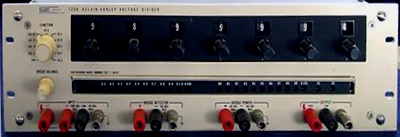
|
|
The Fluke 720A Kelvin-Varley Divider is a high-resolution primary ratio standard with absolute linearity of 0.1 ppm, temperature coefficient of linearity of 0.1 ppm/°C, and self-calibration capability. Specifications. Ratio Range: 0 to 1.0 (1 .0 input tap) and 0 to 1.1 (1 .1 input tap). Resolution: 0.1 ppm of input with seven decades. Absolute Linearity: (At calibration temperature and without the use of a correct chart) ±0.1 ppm of input at dial settings of 1.1 to 0.1, ±0.1 (10S) ^1/3 of input at dial settings (S) of 0.1 to 0. Temperature Coefficient of Linearity: ±0.1 ppm of inputl°C maximum at dial settings of 1.1 to 0.1. Short-Term Linearity Stability: Under typical conditions in a standards laboratory environment (temperature maintained within ±1 °C) and with an applied voltage of up to 100 V, stability of linearity is 0.1 ppm/30 days. Power Coefficient of Linearity: ±0.2 ppm of input/W max at dial settings of 1.1 to 0.1 ; ±0.2 (10S)^2 ppm of input/W max at dial settings (S) of 0.1 to 0. Maximum End Errors: Zero error at output low: 0.004 ppm of input. Zero error at input low: 0.05 ppm of input. Full-scale error: 0.05 ppm of input. Thermal Voltages: ±0.5 µV max. Maximum Input Voltage: 1000V on 1.0 input terminal, 1100 V on 1.1 input terminal. Input Resistance: 100 k-ohm ±0.005% at 1.0 input terminal at 25°C; 110 k-ohm ±0.005% at 1.1 input terminal at 25°C. Temperature Coefficient of Input Resistance: ±1 ppm per °C max
|